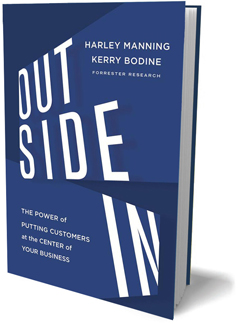Outside In: The Power Of Putting Customers At The Center Of Your Business
 Customer experience is, quite simply, how your customers perceive their interactions with your company. In Forrester’s soon-to-publish book, Outside In, Harley Manning and I show that customer experience is a fundamental business driver and — in an age when customers have access to vast amounts of data about your company and its competitors — it’s also the only sustainable source of competitive advantage.
Customer experience is, quite simply, how your customers perceive their interactions with your company. In Forrester’s soon-to-publish book, Outside In, Harley Manning and I show that customer experience is a fundamental business driver and — in an age when customers have access to vast amounts of data about your company and its competitors — it’s also the only sustainable source of competitive advantage.
In most industries, customer experience is the greatest untapped source of decreased costs. Fidelity Investments recently spent a modest $20,000 to fix a problem that made it difficult for customers to log into their accounts through the company’s automated phone system. This single fix saves Fidelity $4 million a year by averting calls to customer service. And it’s just one of more than 160 projects that came through Fidelity’s experience improvement system in 2011. Together those projects account for more than $24 million in annual savings.
Customer experience also drives increased revenue. Several years ago, B2B technology reseller and service provider CDW added a question to the customer survey it fields: “What additional things would you like to talk to your sales team about?” The company funneled the answers to this new question to the appropriate account managers. The account managers, in turn, closed the loop by getting back to the customers with a simple message: You told us that you have a need, we’d like to offer you something that could meet that need. And guess what? Customers took the CDW sales reps up on it. This seemingly simple innovation drove more than $200 million in incremental revenue in just one year.
Despite its economic power, customer experience remains the most misunderstood element of corporate strategy today. Many companies talk about the importance of customer experience. But to achieve the full potential of customer experience as a business strategy, you have to change the way you run your business. You must manage your business from the outside in — bringing the perspective of your customers to every decision you make — and you must do it in a systematic and repeatable way.
That takes discipline — six of them, actually.
Companies that want to produce a high-quality customer experience need to routinely perform a set of sound, standard practices that fall under six high-level disciplines: strategy, customer understanding, design, measurement, governance, and culture.
- Strategy. First you need to describe the attributes of the intended customer experience and ensure that your vision is consistent with your corporate strategy and brand.
- Customer understanding. Your strategy needs to be informed by a shared understanding of who your customers are, how they perceive the interactions they’re having with your company today, and what they want and need from your company in the future.
- Design. Once you understand your customers’ needs, you can use those insights as part of a human-centered design process that includes iterative idea generation, prototyping, and testing to define new interactions or improve existing ones.
- Measurement. After you design (or redesign) customer interactions, you need to determine whether or not they’re having the effects you intended. That means you need to quantify customer experience quality in a consistent manner across the enterprise and deliver actionable insights to employees and partners.
- Governance. Customer insights and metrics are most valuable when you use them to identify and fix customer problems. To ensure that your company acts on these inputs consistently, you need to proactively manage and oversee customer experience improvement initiatives.
- Culture. To make sure that employees actually adopt all of the above disciplines, you need to create a system of shared values and behaviors that focus employees on delivering a great customer experience.
Customer experience leads to profits — but not because it makes your customers feel warm and fuzzy, and not when it’s just a slogan. Customer experience leads to profits . . . if you treat it as a business discipline.